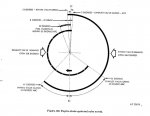- 10,350
- 75
- 48
- Location
- Meadows of Dan, Virginia
FWIW.
What Continental did to improve the LDS for the 1969 M656 8x8 series trucks (rated 200 BHP at 2,800 rpm):
1) Partial load fuel control mechanism in the IP to prevent engine from putting out full power during shifting (auto trans).
2) Increased capacity oil cooler.
3) Increased inside diameter of fuel lines (from IP to injectors)
4) Injector nozzle pressure 3050 to 3150 psi.
5) Fuel filters with top loaded filter elements (love this part). Primary fuel filter is "scraper" type, good for the life of the vehicle.
6) Injectors have different orifice location, whatever that means.
7) Lower capacity oil pan with larger (magnetic) drain plugs.
 Five ring pistons.
Five ring pistons.
9) The crankshaft has increased counter weighting and reduced bearing clearances
10) New camshaft with improved lobe design and new timing events to decrease tappet loading and reduce danger of overspeed failure (max no load engine speed is 3,100 rpm).
11) The turbo is a "dual chambered" or "twin flow", specifically designed for the engine to provide proper air flow at all engine speeds.
12) Intake rocker arms are drilled for better lube of the valve stem.
13) The oil pump has higher capacity. Oil pressure in 5 to 10 seconds (my observation).
14) Improved exhaust and intake valves and seats.
15) Air intake filter canister with precleaner features.
There were also a number of other improvements related to running submerged.
The truck itself weighs about 3,000 lb less that the comparable M54/M809 5-ton for a higher overall weight to horsepower ratio (about 82).
What Continental did to improve the LDS for the 1969 M656 8x8 series trucks (rated 200 BHP at 2,800 rpm):
1) Partial load fuel control mechanism in the IP to prevent engine from putting out full power during shifting (auto trans).
2) Increased capacity oil cooler.
3) Increased inside diameter of fuel lines (from IP to injectors)
4) Injector nozzle pressure 3050 to 3150 psi.
5) Fuel filters with top loaded filter elements (love this part). Primary fuel filter is "scraper" type, good for the life of the vehicle.
6) Injectors have different orifice location, whatever that means.
7) Lower capacity oil pan with larger (magnetic) drain plugs.
9) The crankshaft has increased counter weighting and reduced bearing clearances
10) New camshaft with improved lobe design and new timing events to decrease tappet loading and reduce danger of overspeed failure (max no load engine speed is 3,100 rpm).
11) The turbo is a "dual chambered" or "twin flow", specifically designed for the engine to provide proper air flow at all engine speeds.
12) Intake rocker arms are drilled for better lube of the valve stem.
13) The oil pump has higher capacity. Oil pressure in 5 to 10 seconds (my observation).
14) Improved exhaust and intake valves and seats.
15) Air intake filter canister with precleaner features.
There were also a number of other improvements related to running submerged.
The truck itself weighs about 3,000 lb less that the comparable M54/M809 5-ton for a higher overall weight to horsepower ratio (about 82).
Attachments
-
36.1 KB Views: 52



